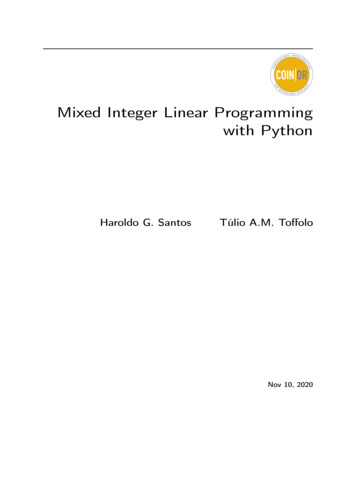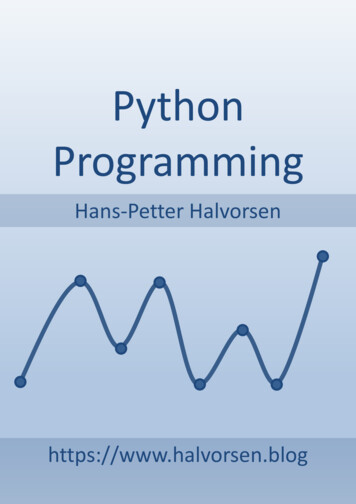
Transcription
PythonProgrammingHans-Petter Halvorsenhttps://www.halvorsen.blog
Python Programming
Python ProgrammingHans-Petter Halvorsen2019
Python Programmingc Hans-Petter HalvorsenAugust 12, 2020ISBN:978-82-691106-4-71
PrefacePython is a popular programming language, and it is one of the most used programming languages today.Python works on all the main platforms and operating systems used today, suchWindows, macOS, and Linux.Python is a multi-purpose programming language, which can be use for simulation, creating web pages, communicate with database systems, etc.My Blog/Web Site [1]:https://www.halvorsen.blogHere you find lots of technical resources about Technology, Programming, Software Engineering, Automation and Control, Industrial IT, etc.Here you find my Web page with Python gramming/python/These resources are a supplement to this textbook. Here you can download thesoftware, download code examples, etc.This Textbook is written in LATEXusing Overleaf.LATEXis a document preparation system used for the communication and publication of scientific documents.2
For more information about LATEX:https://www.latex-project.orgOverleaf is a web-bases LATEXsystem, meaning you can write your LATEXdocumentsin your web browser, you co-work and share documents with others.For more information about Overleaf:https://www.overleaf.comPython BooksYou find other Python textbooks within different domains on my Python amming/python/Python Books: Python Programming - This is a textbook in Python Programmingwith lots of Practical Examples and Exercises. You will learn the necessaryfoundation for basic programming with focus on Python. Python for Science and Engineering - This is a textbook in PythonProgramming with lots of Examples, Exercises, and Practical Applicationswithin Mathematics, Simulations, etc. The focus is on numerical calculations in mathematics and engineering. Necessary theory is presented inaddition to many practical examples. Python for Control Engineering - This is a textbook in Python Programming with lots of Examples, Exercises, and Practical Applicationswithin Mathematics, Simulations, Control Systems, DAQ, Database Systems, etc. The focus is on the use of Python within measurements, datacollection (DAQ), control technology, both analysis of control systems(stability analysis, frequency response, .) and implementation of controlsystems (PID, etc.). Required theory is presented in addition to manypractical examples and exercises in Python. Python for Software Development - This is a textbook in Python Programming with lots of Examples, Exercises, and Practical Applicationswithin Software Systems, Software Development, Software Engineering,Database Systems, Web Application Desktop Applications, GUI Applications, etc. The focus is on the use of Python for creating modern SoftwareSystems. Required theory is presented in addition to many practical examples and exercises in Python.3
ProgrammingThe way we create software today has changed dramatically the last 30 years,from the childhood of personal computers in the early 80s to today’s powerfuldevices such as Smartphones, Tablets and PCs.The Internet has also changed the way we use devices and software. We stillhave traditional desktop applications, but Web Sites, Web Applications and socalled Apps for Smartphones, etc. are dominating the software market today.We need to find and learn Programming Languages that are suitable for theNew Age of Programming.We have today several thousand different Programming Languages today. Iguess you will need to learn more than one Programming Language to survivein today’s software market.You find lots of Programming Resources ing/Software EngineeringSoftware Engineering is the discipline for creating software applications. Asystematic approach to the design, development, testing, and maintenance ofsoftware.The main parts or phases in the Software Engineering process are: Planning Requirements Analysis Design Implementation Testing Deployment and MaintenanceYou find lots of Software Engineering Resources ing/softwaree ngineering/4
5
ContentsIGetting Started with Python101 Introduction111.1 The New Age of Programming . . . . . . . . . . . . . . . . . . . 111.2 MATLAB . . . . . . . . . . . . . . . . . . . . . . . . . . . . . . . 152 What is Python?2.1 Introduction to Python . . . . . . . . . . . . . . .2.1.1 Interpreted vs. Compiled . . . . . . . . . .2.2 Python Packages . . . . . . . . . . . . . . . . . . .2.2.1 Python Packages for Science and Numerical2.3 Anaconda . . . . . . . . . . . . . . . . . . . . . . .2.4 Python Editors . . . . . . . . . . . . . . . . . . . .2.4.1 Python IDLE . . . . . . . . . . . . . . . . .2.4.2 Visual Studio Code . . . . . . . . . . . . . .2.4.3 Spyder . . . . . . . . . . . . . . . . . . . . .2.4.4 Visual Studio . . . . . . . . . . . . . . . . .2.4.5 PyCharm . . . . . . . . . . . . . . . . . . .2.4.6 Wing Python IDE . . . . . . . . . . . . . .2.4.7 Jupyter Notebook . . . . . . . . . . . . . .2.5 Resources . . . . . . . . . . . . . . . . . . . . . . .2.6 Installing Python . . . . . . . . . . . . . . . . . . .2.6.1 Python Windows 10 Store App . . . . . . .2.6.2 Installing Anaconda . . . . . . . . . . . . .2.6.3 Installing Visual Studio Code . . . . . . . . . . . . . . . . . . . . . . . . . . . . .Computations. . . . . . . . . . . . . . . . . . . . . . . . . . . . . . . . . . . . . . . . . . . . . . . . . . . . . . . . . . . . . . . . . . . . . . . . . . . . . . . . . . . . . . . . . . . . . . . . . . .171718192020212122222222232323232424243 Start using Python263.1 Python IDE . . . . . . . . . . . . . . . . . . . . . . . . . . . . . . 263.2 My first Python program . . . . . . . . . . . . . . . . . . . . . . 263.3 Python Shell . . . . . . . . . . . . . . . . . . . . . . . . . . . . . 273.4 Running Python from the Console . . . . . . . . . . . . . . . . . 273.4.1 Opening the Console on macOS . . . . . . . . . . . . . . . 283.4.2 Opening the Console on Windows . . . . . . . . . . . . . 293.4.3 Add Python to Path . . . . . . . . . . . . . . . . . . . . . 293.5 Scripting Mode . . . . . . . . . . . . . . . . . . . . . . . . . . . . 313.5.1 Run Python Scripts from the Python IDLE . . . . . . . . 313.5.2 Run Python Scripts from the Console (Terminal) macOS 323.5.3 Run Python Scripts from the Command Prompt in Windows . . . . . . . . . . . . . . . . . . . . . . . . . . . . . . 336
3.5.4Run Python Scripts from Spyder . . . . . . . . . . . . . .4 Basic Python Programming4.1 Basic Python Program . . . . . .4.1.1 Get Help . . . . . . . . .4.2 Variables . . . . . . . . . . . . .4.2.1 Numbers . . . . . . . . .4.2.2 Strings . . . . . . . . . . .4.2.3 String Input . . . . . . . .4.3 Built-in Functions . . . . . . . .4.4 Python Standard Library . . . .4.5 Using Python Libraries, Packages4.5.1 Python Packages . . . . .4.6 Plotting in Python . . . . . . . .4.6.1 Subplots . . . . . . . . . .4.6.2 Exercises . . . . . . . . .II. . . . . . . . . . . . . . . . . . . . . . . . . . . . . . . . . . . . . . . . . . . . . . . . . . . . . . . . .and Modules. . . . . . . . . . . . . . . . . . . . . . . . . . . . .Python Programming5 Python Programming5.1 If . Else . . . . . . . .5.2 Arrays . . . . . . . . . .5.3 For Loops . . . . . . . .5.3.1 Nested For Loops5.4 While Loops . . . . . . .5.5 Exercises . . . . . . . .33363636363839404041424444474950.515152545758586 Creating Functions in Python606.1 Introduction . . . . . . . . . . . . . . . . . . . . . . . . . . . . . . 606.2 Functions with multiple return values . . . . . . . . . . . . . . . 626.3 Exercises . . . . . . . . . . . . . . . . . . . . . . . . . . . . . . . 637 Creating Classes in Python667.1 Introduction . . . . . . . . . . . . . . . . . . . . . . . . . . . . . . 667.2 The init () Function . . . . . . . . . . . . . . . . . . . . . . . . 677.3 Exercises . . . . . . . . . . . . . . . . . . . . . . . . . . . . . . . 708 Creating Python Modules718.1 Python Modules . . . . . . . . . . . . . . . . . . . . . . . . . . . 718.2 Exercises . . . . . . . . . . . . . . . . . . . . . . . . . . . . . . . 729 File9.19.29.39.49.59.6Handling in PythonIntroduction . . . . . .Write Data to a File .Read Data from a FileLogging Data to File .Web Resources . . . .Exercises . . . . . . .7.74747475757676
10 Error Handling in Python10.1 Introduction to Error Handling10.1.1 Syntax Errors . . . . . .10.1.2 Exceptions . . . . . . .10.2 Exceptions Handling . . . . . .11 Debugging in Python79797979808212 Installing and using Python Packages8312.1 What is PIP? . . . . . . . . . . . . . . . . . . . . . . . . . . . . . 83IIIPython Environments and Distributions13 Introduction to Python Environments13.1 Package and Environment Managers .13.1.1 PIP . . . . . . . . . . . . . . .13.1.2 Conda . . . . . . . . . . . . . .13.2 Python Virtual Environments . . . . .and Distributions. . . . . . . . . . . . . . . . . . . . . . . . . . . . . . . . . . . . . . . . . . . . .84.858686868714 Anaconda8814.1 Anaconda Navigator . . . . . . . . . . . . . . . . . . . . . . . . . 8815 Enthought Canopy90IV91Python Editors16 Python Editors9217 Spyder9418 Visual Studio Code9618.1 Introduction to Visual Studio Code . . . . . . . . . . . . . . . . . 9618.2 Python in Visual Studio Code . . . . . . . . . . . . . . . . . . . . 9719 Visual Studio19.1 Introduction to Visual Studio . . . . . . . . . . . . . . . . .19.2 Work with Python in Visual Studio . . . . . . . . . . . . . .19.2.1 Make Visual Studio ready for Python Programming19.2.2 Python Interactive . . . . . . . . . . . . . . . . . . .19.2.3 New Python Project . . . . . . . . . . . . . . . . . .98. 98. 98. 99. 99. 10020 PyCharm10621 Wing Python IDE10822 Jupyter Notebook11022.1 JupyterHub . . . . . . . . . . . . . . . . . . . . . . . . . . . . . . 11122.2 Microsoft Azure Notebooks . . . . . . . . . . . . . . . . . . . . . 1118
VPython for Mathematics Applications23 Mathematics in Python23.1 Basic Math Functions . . . . . . . .23.1.1 Exercises . . . . . . . . . . .23.2 Statistics . . . . . . . . . . . . . . .23.2.1 Introduction to Statistics . .23.2.2 Statistics functions in Python23.3 Trigonometric Functions . . . . . . .23.4 Polynomials . . . . . . . . . . . . . .VI.Resources24 Python Resources24.1 Python Distributions . .24.2 Python Libraries . . . .24.3 Python Editors . . . . .24.4 Python Tutorials . . . .24.5 Python in Visual StudioVII.113114114116118118119121125128.Solutions to Exercises.1291291291291301301339
Part IGetting Started withPython10
Chapter 1IntroductionWith this textbook you will learn basic Python programming. The textbookcontains lots of examples and self-paced tasks that the users should go throughand solve in their own pace.You will find additional resources on my blog/web site [1].https://www.halvorsen.blogMy Web Site about Python g/python/See Figure 1.11.1The New Age of ProgrammingThe way we create software today has changed dramatically the last 30 years,from the childhood of personal computers in the early 80s to today’s powerfuldevices such as Smartphones, Tablets and PCs.The Internet has also changed the way we use devices and software. We stillhave traditional desktop applications, but Web Sites, Web Applications and socalled Apps for Smartphones, etc. are dominating the software market today.We need to find and learn Programming Languages that are suitable for theNew Age of Programming.We have today several thousand different Programming Languages, so whyshould we learn Python? I guess you will need to learn more than one Programming Language to survive in today’s software market. Python is easy tolearn, so it it a good starting point for new programmers.Python is an interpreted, high-level, general-purpose programming language.Created by Guido van Rossum and first released in 1991 [2].11
Figure 1.1: Web Site - PythonPython is a fairly old Programming Language (1991) compared to many otherProgramming Languages like C# (2000), Swift (2014), Java (1995), PHP (1995).Python has during the last 10 years become more and more popular. Today,Python has become one of the most popular Programming Languages.There are many different rankings regarding which programming language whichis most popular. In most of these ranking, Python is in top 10.One of these rankings is the IEEE Spectrum’s ranking of the top programminglanguages [3].From this ranking we see that Python is the most popular Programming Language in 2018. See Figure 1.2As we see in Figure 1.2 they categorize the different Programming Languagesinto the following categories: Web12
Figure 1.2: The Most Popular Programming Languages Mobile Enterprise EmbeddedAccording to Figure 1.2 we see that Python can be used to program Web Applications, Enterprise Applications and Embedded Applications.So far Python is not used or not optimized for creating Mobile Applications. Wehave today 2 major Mobile platforms; iOS Applications are mainly programmedwith the Swift Programming language, while Android Applications are mainlyprogrammed with either Java or Kotlin.Another survey is the ”Stack Overflow Developer Survey 2018” [4]. See Figure1.3.As we can see from [5] and Figure 1.4, Python becomes more and more popularyear by year.Based on Figure 1.4, the source [5] try to predict the future of Python, seeFigure 1.5.Based on the surveys and statistics mention above, obviously Python is a programming language that you should learn.Lets summarize: Python is fun to learn and use and it is also named after the Britishcomedy group called Monty Python. Python has a simple and flexible code structure and the code is easy toread.13
Figure 1.3: The Top Programming Languages - Stack Overflow Survey Python is highly extendable due to its high number of free availablePython Packaged and Libraries Python can be used on all platforms (Windows, macOS and Linux). Python is multi-purpose and can be used for to program Web Applications,Enterprise Applications and Embedded Applications, and within DataScience and Engineering Applications. The popularity of Python is growing fast. Python is open source and free to use The growing Python community makes it easy to find documentation,code examples and get help when neededIn general, Python is a multipurpose programming language that can be usedin many situations. But there is not one programming language which is bestin all kind of situations, so it is important that you know about and have skillsin different languages.My list of recommendations (one of many): Visual Studio and C LabVIEW - a graphical programming language well suited for hardwareintegration, taking measurements and data logging MATLAB - Numerical calculations and Scientific computing Python - Numerical calculations, and Scientific computing, etc. Web Programming, such as HTML, CSS, JavaScript and a Server-sideframework/programming language like PHP, ASP.NET (C or VB.NET),Django (Python based)14
Figure 1.4: The Incredible Growth of Python Databases (such as SQL Server and MySQL) and using the StructuredQuery Language (SQL) or the upcoming NoSQL databases App Development for the 2 main platforms iOS (XCode using the SwiftProgramming Language) and Android (Android Studio using the JavaProgramming Language or Kotlin Programming language)If you have skills in most of the tools, programming languages and frameworksmention above, you are well suited for working as a full-time programmer orsoftware engineer.1.2MATLABIf you are looking for MATLAB, please see the gramming/matlab/15
Figure 1.5: The Future of Python16
Chapter 2What is Python?2.1Introduction to PythonPython is an open source and cross-platform programming language, that hasbecome increasingly popular over the last ten years. It was first released in1991. Latest version is 3.7.0. CPython is the reference implementation of thePython programming language. Written in C, CPython is the default and mostwidely-used implementation of the language.Python is a multi-purpose programming languages (due to its many extensions),examples are scientific computing and calculations, simulations, web development (using, e.g., the Django Web framework), etc.Python Home Page [6]:https://www.python.orgThe programming language is maintained and available from (Python SoftwareFoundation): https://www.python.org Here you can download the basic Pythonfeatures in one package, which includes the Python programming language interpreter, and a basic code editor, or an integrated development environment,called IDLE. See Figure 2.1But this is just the Python core, i.e. the interpreter a very basic editor, and theminimum needed to create basic Python programs.Typically you will need more features for solving your tasks. Then you can install and use separate Python packages created by third parties. These packagesneed to be downloaded and installed separately (typically you use somethingcalled PIP), or you choose to use, e.g., a distribution package like Anaconda.Python is an object-oriented programming language (OOP), but you can usePython in basic application without the need to know about or use the objectoriented features in Python.Python is an interpreted programming language, this means that as a developer17
Figure 2.1: IDLE - Basic Python Editoryou write Python (.py) files in a text editor and then put those files into thepython interpreter to be executed. Depending on the Editor you are using, thisis either done automatically, or you need to do it manually.Here are some important Python sources: [6], [7], [8].2.1.1Interpreted vs. CompiledWhat are the differences between Interpreted programming languages and Compiled programming languages? What kind should you choose, and why shouldyou bother?Programming languages generally fall into one of two categories: Compiled orInterpreted. With a compiled language, code you enter is reduced to a set ofmachine-specific instructions before being saved as an executable file.Both approaches have their advantages and disadvantages.18
With interpreted languages, the code is saved in the same format that you entered. Compiled programs generally run faster than interpreted ones becauseinterpreted programs must be reduced to machine instructions at run-time. Itis usually easier to develop applications in an interpreted environment becauseyou don’t have to recompile your application each time you want to test a smallsection.Python is an interpreted programming language, while e.g., C/C are translated by running the source code through a compiler, i.e., C/C are compiledlanguages.Interpreted languages, in contrast, must be parsed, interpreted, and executedeach time the program is run.Another example of an interpreted programming language is PHP, which ismainly used to create dynamic web pages and web applications.Compiled languages are all translated by running the source code through acompiler. This results in very efficient code that can be executed any number oftimes. The overhead for the translation is incurred just once, when the sourceis compiled; thereafter, it need only be loaded and executed.During the design of an application, you might need to decide whether to use acompiled language or an interpreted language for the application source code.Interpreted languages, in contrast, must be parsed, interpreted, and executedeach time the program is runThus, an interpreted language is generally more suited for doing ”ad hoc” calculations or simulations, while compiled languages are better for permanentapplications where speed is in focus.2.2Python PackagesWith Python you don’t get so much out of the box. Instead of having all ofits functionality built into its core, you need to install different packages fordifferent topics.This approach has advantages and disadvantages. An disadvantage is that youneed to install these packages separately and then later import these modulesin your code.This is also typical approach for open source software, because everybody cancreate their own Python packages and distribute them. In that way you alsofind Python packages for almost everything, from Scientific Computing to WebDevelopment.19
These packages need to be downloaded and installed separately, or you chooseto use, e.g., a distribution package like Anaconda, where you typically get thepackages you need for scientific computing. With Anaconda you typically getthe same features as with MATLAB.Lots of Python packages exists, depending on what you are going to solve.We have Python packages for Desktop GUI Development, Database Development, Web Development, Software Development, etc.See an overview of Applications for Python:https://www.python.org/about/apps/See also the Python Package Index (PyPI) web site:https://pypi.orgHere you can search for, download and install many hundreds Python Packageswithin different topics and applications. You can also make your own PythonPackages and distribute them here.2.2.1Python Packages for Science and Numerical ComputationsSome important Python Packages for Science and Numerical Computations are: NumPy - NumPy is the fundamental package for scientific computingwith Python [9] SciPy - SciPy is a free and open-source Python library used for scientificcomputing and technical computing. SciPy contains modules for optimization, linear algebra, integration, interpolation, special functions, FFT, signal and image processing, ODE solvers and other tasks common in scienceand engineering. [9] Matplotlib - Matplotlib is a Python 2D plotting library. [10] Pandas - Pandas Python Data Analysis Library [11]These packages need to be downloaded and installed separately, or you chooseto use, e.g., a distribution package like Anaconda, where you typically get thepackages you need for scientific computing. With Anaconda you typically getthe same features as with MATLAB.2.3AnacondaAnaconda is a distribution package, where you get Python compiler, Pythonpackages and the Spyder editor, all in one package.Anaconda includes Python, the Jupyter Notebook, and other commonly usedpackages for scientific computing and data science.20
They offer a free version (Anaconda Distribution) and a paid version (Enterprise) Anaconda is available for Windows, macOS, and /en.wikipedia.org/wiki/Anaconda( P ythond istribution)Spyder and the Python packages (NumPy, SciPy, Matplotlib, .) mention above are included in the Anaconda Distribution.2.4Python EditorsAn Editor is a program where you create your code (and where you can runand test it). Most Editors have also features for Debugging. For simple Pythonprograms you can use the IDLE Editor, but for more advanced programs a better editor is recommended.Examples of Python Editors: Python IDLE Visual Studio Code Spyder Visual Studio PyCharm Wing Python IDE Jupyter NotebookThese editors are shortly described below and in more detail later in this textbook.Which editor you should use depends on your background, what kind of codeeditors you have used previously, your programming skills, what your are goingto develop in Python, etc.2.4.1Python IDLEThe programming language is maintained and available from (Python SoftwareFoundation): https://www.python.org Here you can download the basic Pythonfeatures in one package, which includes the Python programming language interpreter, and a basic code editor, or an integrated development environment,called IDLE. See Figure 2.1Web:https://www.python.org21
2.4.2Visual Studio CodeVisual Studio Code is a source code editor developed by Microsoft for Windows,Linux and macOS.Web:https://code.visualstudio.comResources: Getting Started with Python in Visual Studio Code2.4.3SpyderSpyder is an open source cross-platform integrated development environment(IDE) for scientific programming in the Python ttps://en.wikipedia.org/wiki/Spyder( sof tware)Spyder is included in the Anaconda Distribution.2.4.4Visual StudioMicrosoft Visual Studio is an integrated development environment (IDE) fromMicrosoft. It is used to develop computer programs, as well as websites, webapps, web services and mobile apps. The deafult (main) programming languagein Visual studio is C, but many other programming languages are supported.Visual studio is available for Windows and macOS.Visual Studio (from 2017), has integrated support for Python, it is called”Python Support in Visual kipedia:https://en.wikipedia.org/wiki/MicrosoftV isualS tudio2.4.5PyCharmPyCharm is cross-platform, with Windows, macOS and Linux versions. TheCommunity Edition is free to use, while the Professional Edition (paid version)has some extra features.22
Web:https://www.jetbrains.com/pycharm/2.4.6Wing Python IDEThe Wing Python IDE family of integrated development environments (IDEs)from Wingware were created specifically for the Python programming language.3 different version of Wing exists [12]: Wing 101 – a very simplified free version, for teaching beginning programmers Wing Personal – free version that omits some features, for students andhobbyists Wing Pro – a full-featured commercial (paid) version, for professionalprogrammers2.4.7Jupyter NotebookThe Jupyter Notebook is an open-source web application that allows you to create and share documents that contain live code, equations, visualizations .wikipedia.org/wiki/ProjectJ upyter2.5ResourcesHere are some useful Python resources: The official Python Tutorial- https://docs.python.org/3.7/tutorial/index.html The official Python Documentation- https://docs.python.org/3.7/index.html Python Tutorial (w3schools.com) [13]- https://www.w3schools.com/python/2.6Installing PythonThe Python programming language is maintained and available from (PythonSoftware Foundation):23
https://www.python.orgHere you can download the basic Python features in one package, which includesthe Python programming language interpreter, and a basic code editor, or anintegrated development environment, called IDLE. See Figure 2.1For basic Python programming this is good enough.For more advanced Python Programming you typically need a better Code Editor and additional Packages.For the basic Python examples in the beginning, the basic Python softwarefrom:https://www.python.org is good enough.I suggest you start with the basic Python software in order to learn the basics,then you can upgrade to a better Editor, install addition Python packages (eithermanually or or install Anaconda where ”everything” is included).2.6.1Python Windows 10 Store AppPython 3.7 is also available in the Microsoft Store for Windows 10.The Microsoft Store version of Python 3.7 is a simplified installer for runningscripts and packages.Microsoft Store version of Python 3.7 is very basic but it’s good enough to runthe simple scripts.Python 3.7 Microsoft Store edition will receive all updates automatically whenthey are released and no manual action is required from your end.In order to install the Microsoft Store version of Python just open MicrosoftStore in Windows 10 and search for Python.2.6.2Installing AnacondaThe Spyder Code Editor and the Python packages (such as NumPy, SciPy, matplotlib, etc) are included in the Anaconda Distribution.Download and install from:https://www.anaconda.com2.6.3Installing Visual Studio CodeVisual Studio Code code is a simple and easy to use editor that can be used formany different programming languages.24
Download and install from:https://code.visualstudio.comGetting Started with Python in Visual Studio hon-tutorial25
Chapter 3Start using PythonIn this chapter we will start to use Python in some simple examples.3.1Python IDEThe basic code editor, or an integrated development environment, called IDLE.See Figure 3.1.Other Python Editors will be discussed more in detail later. For now you canuse the basic Python IDE (IDLE) or Spyder if you have installed the Anacondadistribution package.Figure 3.1: Python Shell / Python IDLE Editor3.2My first Python programWe will start using Python and create some code examples.26
Example 3.2.1. Plotting in PythonLets open your Python Editor and type the following:1p r i n t ( ” H e l l o World ! ” )Listing 3.1: Hello World Python Example[End of Example]An extremely useful command is help(), which enters a help functionality toexplore all the stuff python lets you do, right from the interpreter. Press q toclose the help window and return to the Python prompt.You can use Python in different ways, either in ”interactive” mode or in ”Scripting” mode.The python program that you have installed will by default act as somethingcalled an interpreter. An interpreter takes text commands and runs them asyou enter them - very handy for trying things out.Yo can run Pyt
Python is a popular programming language, and it is one of the most used pro-gramming languages today. Python works on all the main platforms and operating systems used today, such Windows, macOS, and Linux. Python is a multi-purpose programming language, which can be use for simu-lation, cr
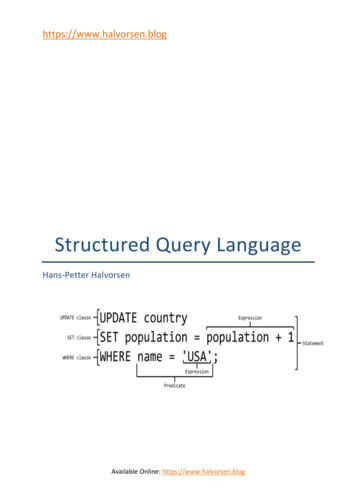

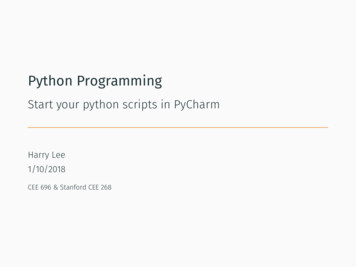
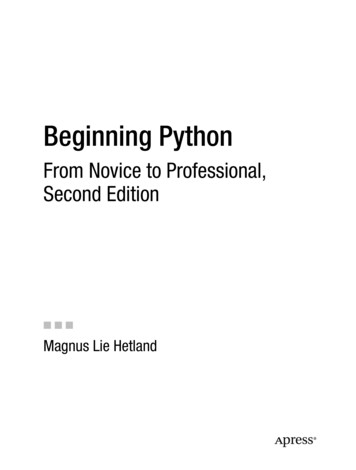


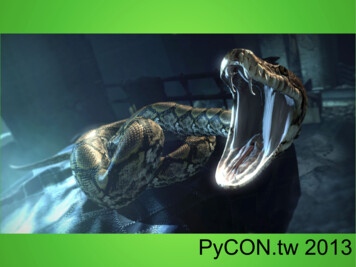
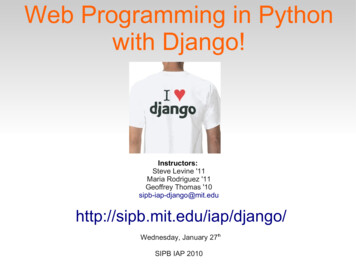

![Fluent Python : [clear, concise, and effective programming]](/img/1/799981060.jpg)
